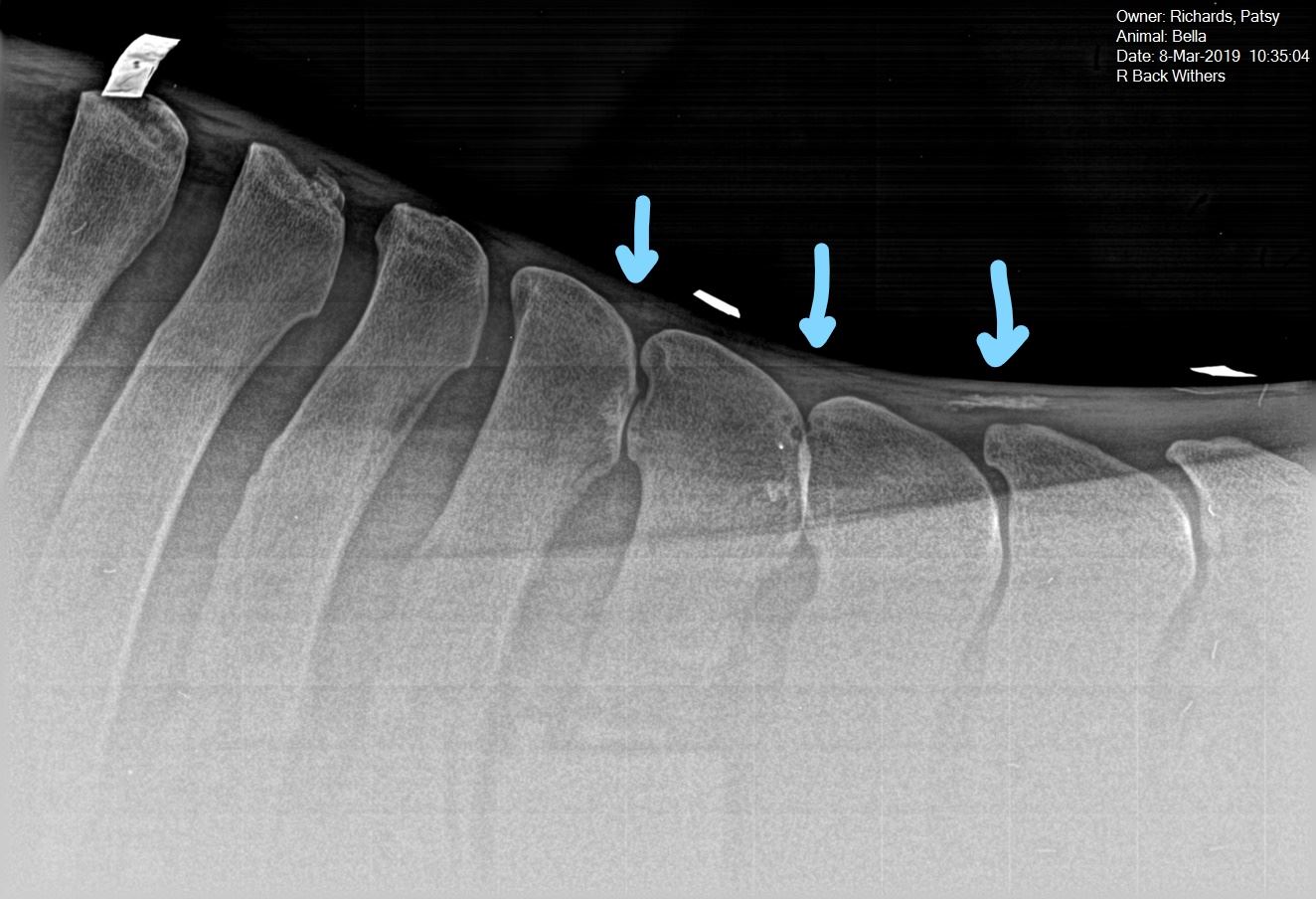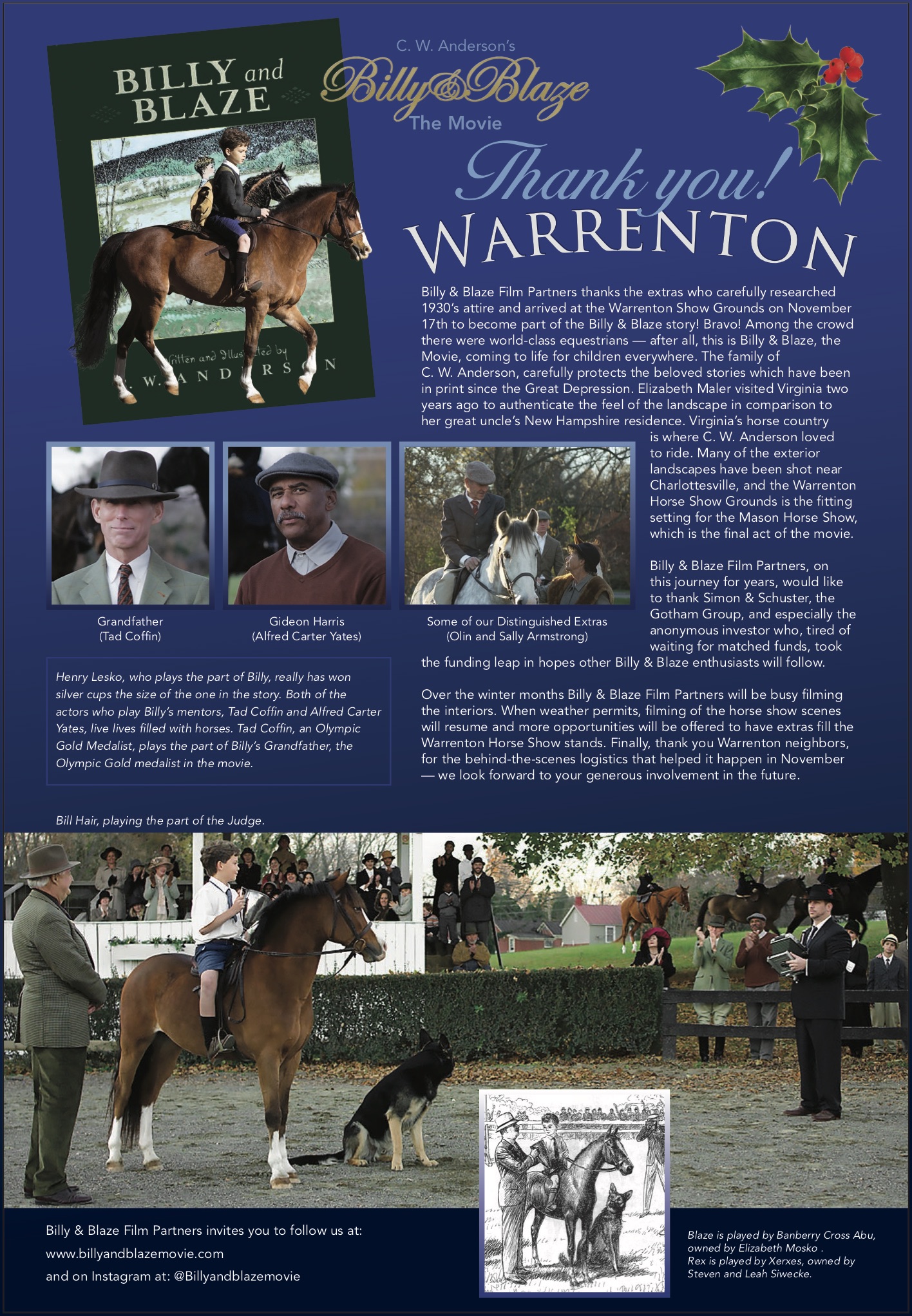No more painful kissing spine. Bella moves beautifully with the use of Smart Ride Rx and Thera-Tree®.
Read more"Under Pressure" uses Thera-Tree® to capture the win!
Congratulations to owner Mallory Greiner and trainer Chris Richard on the recent successes of their racehorse “UnderPressure,” who has won 2 out of 3 stakes races since he began wearing the Thera-Tree.
Read moreThera-Tree® & SmartRideRx - For Kissing Spine.
Introducing Bella & An Alternate Narrative in Treating Kissing Spine
These are "before and after" x-rays of a horse named Bella with Kissing Spine taken 18 days apart. This horse was 'treated' with our Thera-Tree and ridden in our saddle with Smart Ride Rx technology. NO OTHER THERAPIES, DRUGS OR SUPPLEMENTS WERE GIVEN.
Here's the back story:
Horses hollow their backs to avoid the pressure of painful saddles. If this persists, over time the tips of the spinous processes become closer together. This condition is commonly known as Kissing Spine.
Many of our customers have had great success using our saddles on horses that have been diagnosed with this condition. The technology has allowed these horses to relax their back muscles, creating more space between the tips.
We've been looking for an opportunity to showcase the effects of our technology.
These x-rays belong to Bella, a 10 year old OTTb mare diagnosed on March 8th of this year with Kissing Spine. She had become increasingly difficult to ride and had been out of work for several months. Recommended therapies included continued osteopathic manipulation, surgery or a series of injections. Euthanasia was also discussed.
Learning of her condition, Tad invited her owner, Patsy Richards, to bring Bella to his stable for a Kissing Spine Challenge: Would it be possible, using the Thera-Tree and Smart Ride Rx technology, to put Bella back in work and demonstrate, using radiographs, that her condition could be improved?
Bella received no other therapies, drugs or supplements of any kind from March 8th on.
She arrived on March 16. She spent several hours each day in the Thera-Tree both before and after being ridden by Tad. Each day her pain level decreased and her willingness to work through her back improved.
Bella was x-rayed again on April 3 by the same veterinarian, two and half weeks after arriving. The results, plainly visible, are astonishing. The attending veterinarian confirmed that the spine was 85% back to normal condition. Again, this all happened in the course of 18 days.
Bella continues her work with Tad for another month. We will have x-rays taken again before she returns home to Patsy to be ridden in her new TC saddle.
Creating saddles that allow horses to use their backs correctly has been Tad's focus for over 25 years. It has been the driving force behind the evolution of our technology.
We will continue to post about Bella.
For more information, visit www.thera-tree.com andwww.tadcoffinsaddles.com, or give Tad a call at 434-989-3229 to discuss a horse you know.
#kissingspine #horsecare #aaep #ottb
Thera-Tree® and Smart Ride Rx Eliminate Kissing Spine
KISSING SPINE: Our Thoughts on a Pervasive Problem
Tad has long believed that a condition known as Kissing Spine is principally caused by saddles that inflict back pain in horses. This pervasive problem has caused many horses’ careers to be cut short, while others undergo invasive medical procedures. This diagnosis has even led to some being euthanized.
What is Kissing Spine? Long fingerlike spinous processes stick up from the vertebrae of the equine spine. Muscles cover and connect along these bony extensions form the structure of the horse’s back where saddles sit. Tad explains that when muscles in horses’ backs are painful and tight, these muscles contract and draw the tips of the spinous processes together, and there is no other option than to have these tips get too close. This closeness or rubbing can cause pain. Tad points out that therapies to mitigate this pain will not be a long-term fix if horses are still ridden in the same saddles which cause them discomfort.
This photo above shows the equine spine. Note the space between the tips of the spinous processes. The photo below is of a horse’s spine that has been diagnosed with Kissing Spine. Notice the lack of spacing between the spinal process. You can get a glimpse of the skeletal system in motion in the third image.
Over the past few years we have had considerable success using our saddles on horses with Kissing Spine. Horses that were given a career-ending diagnosis have been able to be ridden and competed with great comfort and success. This is due to the strides we have made in the Smart Ride and now Smart Ride Rx technology.
Recently we have been generously given an opportunity to demonstrate the effect our technology can have on Kissing Spine. An off the track Thoroughbred mare in our area was recently radiographed and diagnosed with Kissing Spine. She’s become a case study to see what changes the Thera-Tree and our saddle with Smart Ride Rx therapy can affect.
This is the first in a multi part series. In sharing this mare's story, we hope to create an alternative narrative on how the issue of Kissing Spine is being addressed.
For more information, visit www.thera-tree.com and www.tadcoffinsaddles.com, or give Tad a call at 434-989-3229.
Thera-Tree® as Therapy for Kissing Spine
Thera-Tree® as therapy for Kissing Spine
Read moreSweet Briar's Win with Tad Coffin Saddles and Thera-Tree®.
Win at Sweet Briar.
Read moreSmartRideRX Brings Pain Relief at Equine Welfare Society
Rescue horses in particular have painful histories and troubled stories that havens like the Equine Welfare Society at Bridlespur Farm in Keswick, Va. work to help. Tad Coffin's SmartRide Rx technology in his saddles and now also in the Thera-Tree® was a big breakthrough for four of these horses who experienced the pain relieving, relaxing, and performance improving effects of the latest technology.
EWS Director Erica Stevens said "We are constantly pursuing different options to help increase quality of life and welfare of our herd while they are transitioning to healthy and fit adoptables. We think the SmartRide Rx technology fits seamlessly into our program and will provide these horses with the comfort and healing they need, both mentally and physically. I look forward to exploring the Thera-Tree® as part of the rehabilitation and training of Equine Welfare Society horses!”
One of the auditors of the program was Carly Cowherd, DVM. As a practitioner of Western veterinary medicine, she came to the program with a bit of skepticism about any new alternative therapy. After watching the horses experience the effects of the Thera-Tree®, she noted the following: “They were all licking and chewing, demonstrating clearly relaxed demeanors. The degrees of change were dependent on the horse-- some of them fell asleep, others were more still, less agitated. I could definitely see that something was happening. Though it is not a common therapy, I could see that it is definitely a tool that I could employ.”
Then Tad traded the Thera-Tree® for his saddle with the same SmartRide Rx technology inside it to continue the therapeutic effects as he rode “Shanti”. This horse started out the evening painfully back sore. After wearing the Thera-Tree® for an hour, her back pain was significantly alleviated. When Tad rode her, the fluid way of going and the relaxed expression of the mare indicated a high degree of comfort. “It looked like she was enjoying the ride. She went really beautifully,” said Dr. Cowherd.
What was quite remarkable was that Tad spent most of his ride at the sitting trot or deep seat canter, a counter intuitive approach to riding a horse with back pain.
At the end of the ride, Tad removed the saddle, tested for pain and the mare showed no reaction whatsoever.
For a horse to begin a session crumpling from the touch of a person to her back to being ridden in a saddle in full seat to finishing with no back pain is unexpected, if not remarkable. It is certainly a new horizon for us to consider when it comes to saddles.
EWS Director Erica Stevens said “I’ve received very enthusiastic feedback and it was our best attended Winter Workshop to date. I applaud Tad’s commitment to equine welfare and passion for utilizing technology to maximize the health and comfort of horses.”
We know that this technology can make a significant impact on the well-being of rescue horses throughout the country and across the world, and look forward to continuing to work with horse welfare groups, including groups that work with off-track Thoroughbreds.
To see what SmartRide Rx technology can do for the welfare of your horse and enhance your partnership with him, give Tad a call to sign up for a Thera-Tree® as a monthly rental or inquire about his saddles: (434) 989-3229. You can also read more about it by visiting www.tadcoffinsaddles.com andwww.thera-tree.com.
Facebook, March 15th 2019
Billy and Blaze
Melissa Holland, DVM, DACVA
Melissa Holland, DVM, DACVA
This thing is just too intriguing for words! As with all things new, there will be naysayers and skeptics. I’m one myself. But here’s the thing that I think I forget sometimes: My chiropractor teachers told us that just because the animals don’t speak your language doesn’t mean they are not talking. You just aren’t listening. You think you know your horse and his quirks until something that you change makes you realize that it’s not the horse with the quirks. Quirks are just compensation for the rider not getting through with his message. This saddle feels like a translator. And, if you are listening, the horse is telling you what he’s hearing. It’s a revelation. You just never know what will cross your path when all you want to do is improve your horse’s life, even if you are not quite sure it needs improving. Something is just nagging at you, so you go searching.
TCPS in Horse Talk Magazine →
"We have ridden horses thousands of years, yet we have never seriously explored the saddle as a tool" - Read more about Tad Coffin's mission in Horse Talk Magazine
Read more










